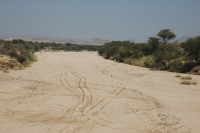Thursday, May 2, 2024
News and Views from the Global South
WATER-NAMIBIA: Running A Dry River
Servaas van den Bosch
- The Omaruru River basin is one of the first in Namibia to establish a basin management committee. Its members have a difficult balancing act to perform with a water resource that’s already being utilised to its maximum.

The Omaruru river runs dry for much of the year, but along with the aquifers it feeds is a vital source of water for a wide area. Credit: Servaas van den Bosch/IPS
“With twelve new mines scheduled to pop up here in the next couple of years, water availability is a great concern,” says Haynes McFadden, secretary of the 16-member Omaruru Basin Management Committee that speaks for the 55,700 inhabitants of the area. McFadden is also chair of the Omaruru branch of the Namibian Chamber of Commerce.
Although arid Namibia embraced an integrated water resources management (IWRM) approach more than ten years ago, government seems in no hurry to let its citizens have a greater say.
IWRM principles recognise that various uses of water are interdependent and that management of water should encompass social and economic goals, including sustainable development. Accomplishing this involves the joint participation of policy-makers, planners and users.
"The water situation on the coast is quite precarious," says Greg Christelis, deputy director of geohydrology of the ministry responsible for water resources. "With the uranium mines the sustainable yield of the aquifers is over utilised. This is why desalination plants are necessary."
Exotic options such as towing icebergs from Antartica, harvesting coastal fog or transporting fresh water from the Democratic Republic of Congo have been considered to alleviate Namibia’s predicament.
But the best alternative to scarce groundwater, experts agree, is desalination plants. One of these, with an envisaged annual capacity of 20 million cubic meters is being built at Wlotzkasbaken on the coast.
Another desalination plant by Namwater near Swakopmund is still on the drawing board.
“Upstream, irrigation farming and the Omaruru municipality are operating on about the maximum capacity of the aquifer. If the river doesn’t come down for a year or two it might lead to a serious problem,” says Greg Christelis, deputy director of geohydrology at Namibia’s ministry of agriculture, water and forestry.
While the river basin itself is only forty to eighty kilometres wide, its aquifers are the main source of water for most of the 63,720 square kilometre Erongo Region, that contains one of the world’s prime uranium deposits.
To balance water use, the basin committee is structured to represent all stakeholders such as local or regional authorities, conservancies, the business community, the mines, the farmers, the ministries and Namwater, says McFadden.
”We have identified 13 groups that use water in this area and that need to consult each other on how to share the resources. All of them are on the committee.”
An executive committee of four volunteers and led by the regional councillor for Omaruru is responsible for the day to day management. “The cooperation in the committee is excellent,” stresses McFadden.
But collaboration with the ministry of agriculture, water and forestry is has been difficult. The basin committee, established in November 2008 with 150,000 U.S. dollars from Danish development agency DANIDA through the SADC Regional Water Sector Programme, was only officially recognised by the ministry in June this year. According to insiders, the entire committee had to threaten to resign to gain this recognition, something that didn’t go down well with the Danish donors.
Interviews for a basin coordinator position were held after many delays at the ministry in early August, but once again there are budgetary restraints.
“We are in the consolidation phase of the project,” says Aune Amwaama, basin co-ordinator from the ministry of agriculture, water and forestry in Windhoek. “SADC funding will stop in November and we will need to source new funding from donors or other parties to sustain the position of a basin coordinator.”
Amwaama admits that the committees operate under constraints. “There is for instance no budget approved and no place to operate from,” she says. “Because the Act is not yet implemented, committees lack the legal back-up to raise money from license fees.”
Offers from local businessmen to supply the committee with office space were regarded with suspicion by the ministry and declined, say committee members. Instead the ministry has offered an office in its department of Rural Water Supply in Karibib.
“Over 60 kilometres from Omaruru,” fumes McFadden.
Such problems are not specific to the Omaruru basin: five years after the Act was passed, it has not been fully implemented. Only a handful of basin management committees has been established.
It could be a worrying sign of doubt at the highest level over how best to implement the IWRM strategy. A ministry official, who prefers not to be named, says the plethora of committees might be counter-productive.
“It’s not so much about the ministry not wanting to relinquish control, because it’s there to give expert advice to the committees,” the official told IPS.
But what can be problematic is that the Act ties water management up with specific basins, while water users such as mines get water from all over. The Act is too rigid here.”
At present the mines are supplied by parastatal Namwater from the Omdel dam, 100 kilometres upstream from the Omaruru River mouth, while also receiving water from the Kuiseb River to the south, putting stress on both.
Amwaama: “Omaruru is one of the first basins to establish a committee, exactly because of the mines and because the area is completely dependent on rainfall. If there are three consecutive dry years, it will lead to huge problems.”
And these are the concerns surfacing at the basin committee.”This committee should have the power to stop a new mine from becoming operational if hasn’t made alternative water arrangements,” says McFadden.
“We want to be what our constitution says us to be, an independent body that enjoys all rights it is entitled to under the Act.”
Balancing the competing needs of various users – and caring for the long-term health of the water resources they are all dependent on – is just what the basin committees are intended to do; it may well require sometimes uncomfortable changes in the way things get done.

 Print
Print



